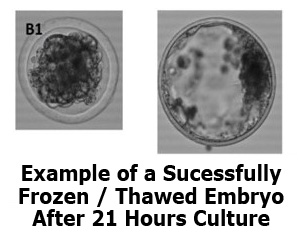
What to Look for When Purchasing Frozen Embryos
Post Date: February 6, 2016

The survival of frozen-thawed-transferred embryos depends on several factors, and they are based on a subjective classification of quality expressed as #1, 2 or 3 meaning excellent, good or fair quality. However, classification is not 100% reliable as the grading scores vary among practitioners, plus as we have learned over the relatively brief years of embryo transfer, embryos recorded as #1 from one donor may result in excellent pregnancy rates, while #1 embryos from another donor may result in a very disappointing pregnancy rate.
Many practitioners and researchers describe good quality embryos as viable which is not an accurate term and possibly leads to the thought that a calf will result more often from an embryo described as viable after transfer. The correct terminology is a transferable quality embryo. Viable means, capable of developing and growing and this is not always the case. But there are other factors (apart from the quality and preparation of the recipient) which can be a significant help in predicting pregnancy rates.
These additional factors can be deduced from an accurately filled out international embryo transfer certificate which should always accompany frozen embryos at the time of sale. Unfortunately, too often there is no certificate, but it may not be the fault of the embryo transfer practitioner. For instance the owner of the embryos may have been given a certificate for 10 frozen embryos but 2 are sold to one buyer, 3 to another and 5 to a third buyer. Unfortunately the seller did not make copies of the certificate for the 3 buyers.
More factors to consider which affect the establishment of a successful pregnancy are:
Dr. Peter Elsden
Click to View More Related Articles

The survival of frozen-thawed-transferred embryos depends on several factors, and they are based on a subjective classification of quality expressed as #1, 2 or 3 meaning excellent, good or fair quality. However, classification is not 100% reliable as the grading scores vary among practitioners, plus as we have learned over the relatively brief years of embryo transfer, embryos recorded as #1 from one donor may result in excellent pregnancy rates, while #1 embryos from another donor may result in a very disappointing pregnancy rate.
Many practitioners and researchers describe good quality embryos as viable which is not an accurate term and possibly leads to the thought that a calf will result more often from an embryo described as viable after transfer. The correct terminology is a transferable quality embryo. Viable means, capable of developing and growing and this is not always the case. But there are other factors (apart from the quality and preparation of the recipient) which can be a significant help in predicting pregnancy rates.
These additional factors can be deduced from an accurately filled out international embryo transfer certificate which should always accompany frozen embryos at the time of sale. Unfortunately, too often there is no certificate, but it may not be the fault of the embryo transfer practitioner. For instance the owner of the embryos may have been given a certificate for 10 frozen embryos but 2 are sold to one buyer, 3 to another and 5 to a third buyer. Unfortunately the seller did not make copies of the certificate for the 3 buyers.
More factors to consider which affect the establishment of a successful pregnancy are:
- The age of the embryo e.g. bovine embryos recorded as Day 6, 7 or 8 yield the best chances of success, but Day 5 or 9 embryos will result in poor pregnancy rates.
- The stage of development of the embryo in relation to its age e.g. Day 6 embryos should be compacted morulae (#4), not a loose or morula with round cells. Day 7 embryos should be blastocysts (# 5, 6 or 7).
- How competent was the technician performing the freezing process? This can be difficult to resolve, however references may help, plus does a certificate accompany the embryos, is it filled out completely and legibly.
- Are the embryos in yellow DT straws, sitting in yellow goblets with a yellow tab on the cane depicting the donor and date of freezing?
- The number of hours between embryo collection and freezing. From observations by two experienced embryo transfer practitioners, embryos should be frozen within 3 to 5 hours after collection for optimum results. Remember all of these facts can be obtained from the IETS certificate.
Dr. Peter Elsden
Click to View More Related Articles
Testimonials
"The majority of our insight to embryo transfer is definitely accredited to Dr. Peter Elsden. The pragmatic experiences and personal attention offered through The International Embryo Technology School are highly commendable."… "An example of the benefits to our embryo transfer program, made possible by The International Embryo Technology School, is a cow that produces embryos for only $20 a piece. Each embryo is valued at $1,500 or more! We hold Dr. Peter Elsden and International Embryo Technology School with our highest regard, as they are largely responsible for our accomplishments."
Bob & Robin Stevenson
Stevenson Angus Ranch

|
|
|